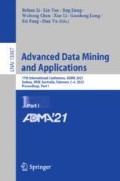Abstract
We propose a new practical fuzzification of classical Kolmogorov complexity to measure the minimum amount of fuzzy algorithmic information needed to produce generic fuzzy data and we then cultivate the foundation of such a fuzzification. In this work, we view Kolmogorov complexity as a measure indicating the size of the maximally compressed data, from which the best possible decompressor algorithmically recovers the original data. As such decompressors, we use a generalized model of deterministic fuzzy Turing machines of Yamakami [SCIS 2014 & ISIS 2014, pp. 29–35] and introduce the notion of fuzzy Kolmogorov complexity of generic fuzzy data based on this computational model. As a direct application to data-mining issues, such as clustering and classification, we provide a set of new practical information distances induced by our notion of fuzzy Kolmogorov complexity.
Access this chapter
Tax calculation will be finalised at checkout
Purchases are for personal use only
Notes
- 1.
- 2.
- 3.
A nonnegative function \(g:\varSigma ^*\times \varSigma ^*\rightarrow \mathbb {R}\) is called a metric if (i) g satisfies the identity property (i.e., \(g(x,y)=0\) iff \(x=y\)), (ii) g is symmetric, and (iii) g satisfies the triangle inequality.
References
Bedregal, B.C., Figueira, S.: On the computing power of fuzzy Turing machines. Fuzzy Sets Syst. 159, 1072–1083 (2008)
Bernstein, E., Vazirani, U.: Quantum compelxity theory. SIAM J. Comput. 26, 1411–1473 (1997)
Berthiaume, A., van Dam, W., Laplante, S.: Quantum Kolmogorov complexity. J. Comput. System Sci. 63, 201–221 (2001)
Castro, J.L., Delgado, M., Mantas, C.J.: A new approach for the execution and adjustment of a fuzzy algorithm. Fuzzy Sets Syst. 121, 491–503 (2001)
Chaitin, G.: On the length of programs for computing finite binary sequences. J. ACM 13, 547–569 (1966)
Dai, S.: Fuzzy Kolmogorov complexity based on a classical description. Entropy 22, article 66 (2020)
Doostfatemeh, M., Kremer, S.: New directions in fuzzy automata. Int. J. Approx. Reason. 38, 175–214 (2005)
Doty, D., Moser, P.: Feasible depth. In: Cooper, S.B., Löwe, B., Sorbi, A. (eds.) CiE 2007. LNCS, vol. 4497, pp. 228–237. Springer, Heidelberg (2007). https://doi.org/10.1007/978-3-540-73001-9_24
Elkan, C.: Using the triangle inequality to accelerate k-means. In: Proceedings of ICML 2003, pp. 147–153. AAAI Press (2003)
Faloutsos, C., Megalooikonomou, V.: On data mining, compression, and Kolmogorov complexity. Data Min. Knowl. Disc. 15, 3–20 (2007)
Gács, P.: Quantum algorithmic entropy. J. Phys. A: Math. Gen. 34, 6859–6880 (2001)
Hanss, M.: Applied Fuzzy Arithmiteic: An Introduction with Engineering Applications. Springer, Berlin (2010)
Jordon, L., Moser, P.: On the difference between finite-state and pushdown depth. In: Chatzigeorgiou, A., et al. (eds.) SOFSEM 2020. LNCS, vol. 12011, pp. 187–198. Springer, Cham (2020). https://doi.org/10.1007/978-3-030-38919-2_16
Keogh, E., Lonardi, S., Wei, L., Ratanamahatana, C.A., Lee, S.H., Handley, J.: Compression-based data mining of sequential data. Data Min. Knowl. Disc. 14, 99–129 (2007)
Kolmogorov, A.: Three approaches to the quantitative definition of information. Probl. Inform. Transm. 1, 1–7 (1965)
Lee, E.T., Zadeh, L.A.: Note on fuzzy languages. Inf. Sci. 1, 421–431 (1969)
Li, M., Vitányi, P.: An Introduction to Kolmogorov Complexity and Its Applications, 3rd edn. Springer-Science, New York (2008)
Li, Y.: Fuzzy Turing machines: variants and universality. IEEE Trans. Fuzzy Syst. 16, 1491–1502 (2008)
Luca, A.D., Termini, S.: Entropy of L-fuzzy set. Inform. Control 24, 55–73 (1974)
Moniri, M.: Fuzzy and intuitionistic fuzzy Turing machines. Fundamenta Informaticae 123, 305–315 (2013)
Mordenson, J.N., Malik, D.S.: Fuzzy Automata and Languages: Theory and Applications. Chapman and Hall, London, U.K. (2002)
Needham, S., Dowe, D.: Message length as an effective Ockham’s razor in decision tree induction. In: Proceedings of AISTATS 2001, pp. 216–223 (2001)
Pal, N., Pal, S.: Higher order fuzzy entropy and hybrid entropy of a fuzzy set. Inf. Sci. 61, 211–221 (1992)
Rissanen, J.J.: Modeling by the shortest data description. Automatica 14, 465–471 (1978)
Santos, E.S.: Fuzzy algorithms. Inform. Control 17, 326–339 (1970)
Solomonoff, R.A.: A formal theory of inductive inference, part I. Inform. Control 7, 1–22 (1964)
Vitányi, P.M.: Quantum Kolmogorov compelxity based on classical descriptions. IEEE Trans. Inform. Theory 47, 2464–2479 (2001)
Wallace, C.S., Boulton, D.M.: An information measure for classification. Comput. J. 11, 185–195 (1968)
Wang, H., Qiu, D.: Computing with words via Turing machines: a formal approach. IEEE Trans. Fuzzy Syst. 11, 742–753 (2003)
Wiedermann, J.: Characterizing the super-turing computing power and efficiency of classical fuzzy Turing machines. Theor. Comput. Sci. 317, 61–69 (2004)
Yager, R.: On the measure of fuzziness and negation, part I: membership in the unit interval. Int. J. Gen. Syst. 5, 221–229 (1979)
Yamakami, T.: The world of combinatorial fuzzy problems and the efficiency of fuzzy approximation algorithms. In: Proceedings of the Joint Conference of SCIS 2014 and ISIS 2014, pp. 29–35. IEEE (2014). arXiv: 1509.03057
Yamakami, T.: Quantum logical depth and shallowness of streaming data by one-way quantum finite-state transducers (preliminary report). In: Proceedings of UCNC 2021. LNCS, vol. 12984, pp. 177–193. Springer (2021)
Zadeh, L.A.: Fuzzy sets. Inform. Control 8, 338–353 (1965)
Zadeh, L.A.: Fuzzy algorithms. Inform. Control 12, 94–102 (1968)
Author information
Authors and Affiliations
Editor information
Editors and Affiliations
Rights and permissions
Copyright information
© 2022 Springer Nature Switzerland AG
About this paper
Cite this paper
Yamakami, T. (2022). Fuzzy Kolmogorov Complexity Based on Fuzzy Decompression Algorithms and Its Application to Fuzzy Data Mining. In: Li, B., et al. Advanced Data Mining and Applications. ADMA 2022. Lecture Notes in Computer Science(), vol 13087. Springer, Cham. https://doi.org/10.1007/978-3-030-95405-5_30
Download citation
DOI: https://doi.org/10.1007/978-3-030-95405-5_30
Published:
Publisher Name: Springer, Cham
Print ISBN: 978-3-030-95404-8
Online ISBN: 978-3-030-95405-5
eBook Packages: Computer ScienceComputer Science (R0)

